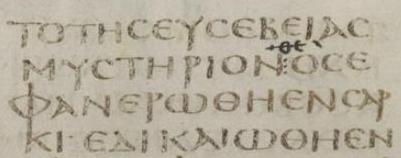“And without controversy great is the mystery of godliness: God was manifest in the flesh, justified in the Spirit, seen of angels, preached unto the Gentiles, believed on in the world, received up into glory.”
“The question is, whether the true reading be
‘God was manifested in the flesh,’ or ‘Who was manifested
in the flesh.’ The evidence on each side is too long and intricate
to be here detailed. The difficulty is very great, either way. To
the writer of this pamphlet it appears that impartial criticism
most favours the latter reading. If the English reader should
wonder how two words, which to his eye and ear seem so different
from each other, could ever come to be confounded, he
may not dislike to be informed that, as they appear in the most
ancient Greek manuscripts, they are so much alike that under
various conceivable and very probable circumstances,
ΟC which*,
might easily be mistaken for
ΘC God. The difference lies only
in two small strokes; and those strokes might spew through the
parchment front the writing on the other side, or the writing at
that part might be accidentally faint, or the parchment thin or
discoloured. After a careful consideration of the words, the
connexion, the apparent train of thought, and the characteristic
style of the apostle Paul, I am led to think that the following
arrangement (of which the principal idea is derived from Dr.
Cramer, of Kiel, in Holstein) and paraphrastic translation most
faithfully represent the sense of the original.”
—John Pye Smith, An Answer To A Printed Paper Entitled MANIFESTO of the CHRISTIAN EVIDENCE SOCIETY (by Robert Taylor)(1827).
* 2nd edition reads “who”.
** Below is an image from the Codex Sinaiticus.
“Codex Sinaiticus, a manuscript of the Christian Bible written in the middle of the fourth century, contains the earliest complete copy of the Christian New Testament. The hand-written text is in Greek. The New Testament appears in the original vernacular language (koine) and the Old Testament in the version, known as the Septuagint, that was adopted by early Greek-speaking Christians. In the Codex, the text of both the Septuagint and the New Testament has been heavily annotated by a series of early correctors.”
—http://codexsinaiticus.org/

Notice end of 2nd line, the ΘC has been
corrected to
![]() .
Whether this correction is justifiable is the matter on which Robert Taylor and John Pye Smith disagreed.
.
Whether this correction is justifiable is the matter on which Robert Taylor and John Pye Smith disagreed.
—image from Codex Sinaiticus: library: BL folio: 294b scribe:
A. Top of 3rd column.
http://codexsinaiticus.org/en/manuscript.aspx?book=47&chapter=3
The letter ‘C’ is a Greek uncial Sigma. ΟC is the uncial script for ὅς (transliteration: hos), which is the third person singular masculine pronoun for “the.” (—Acharya S, personal correspondence, June 7, 2012.)